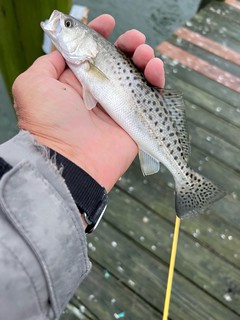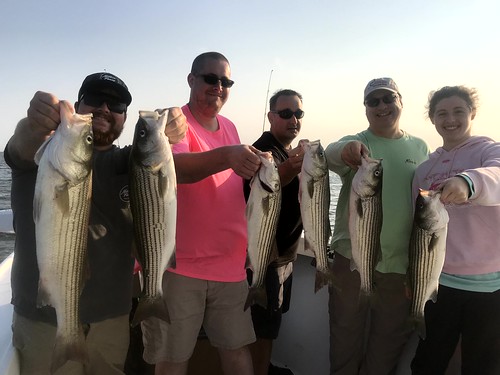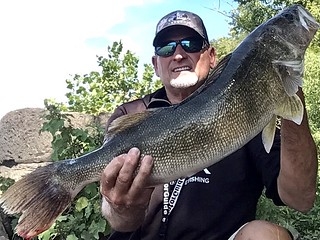Maryland Fishing Report – October 5
Welcome to the great month of “Rocktober!” The recent wind and rain from the remnants of Hurricane Ian has created difficult conditions, but the weather should be improving soon. Anglers saw some exciting fishing action prior to the storm and are anticipating some good fishing in the coming days. Across the state, cooling water temperatures should cause both freshwater and saltwater fish to feed more aggressively prior to the winter months.
Forecast Summary: October 5 – October 11:
Following some warmer conditions on Thursday and Friday, weather conditions this week will be cool and dry. The changing weather patterns will result in windy conditions on Wednesday, Friday, and Saturday, with winds 10 to 20 knots and gusts. Chesapeake Bay surface water temperatures have dropped to the mid 60s and should continue cooling all week. Maryland rivers are currently running in the upper 50s.
Due to the cooled waters and windy conditions this past week, turnover has occurred, and the Bay waters have mixed from surface to bottom resulting in good oxygen conditions and uniform water temperatures throughout the water column. This will result in cool-water preferring fish being able move more vertically in many areas and be more scattered until turnover conditions stabilize. As surface waters continue to cool, deeper waters will remain slightly warmer.
Expect above average flows for most Maryland rivers and streams due the remnants of Ian. There will be above average tidal currents Thursday through Tuesday due to the upcoming full moon October 10.
Expect poor water clarity for Maryland portions of the Bay and rivers from increased flows following the rain. To see the latest water clarity conditions, check Eyes on the Bay Satellite Maps on the Maryland Department of Natural Resources website.
As always, best fishing areas could be further refined by intersecting them with underwater points, hard bottom, drop-offs, and large schools of baitfish.
For more detailed and up-to-date fishing conditions in your area of the Bay, be sure to check out Eyes on the Bay’s Click Before You Cast.
Anglers at the Conowingo Dam pool and at the edges of the Susquehanna Flats are anticipating an improvement in striped bass fishing with the cooling water temperatures. The best tactics are casting poppers, crankbaits, and paddletails during the early morning hours. The mouths of the tidal rivers in the upper Bay should also provide striped bass action for those casting along shoreline structure, points, and the edges of grass beds.
The most popular ways to fish for striped bass in the upper Bay remain live-lining a mix of spot, eels, or white perch, or drifting fresh cut bait or peeler crab. However, with the cooling water temperatures, spot will soon be gone. Striped bass should still be holding in the Pooles Island area, the Tolchester Lumps, the mouth of the Patapsco, Swan Point, and the Love Point rocks.
Jigging at the Love Point rocks and the Key Bridge is a good alternative to bait fishing. With the cooler water temperatures, jigging for striped bass should be improving. Prior to the storm, striped bass and small bluefish were found feeding on small menhaden and bay anchovies under diving birds and slicks. Bluefish may now start moving south down the bay. The edges of the major channels are always a good place to look for schools of bay anchovies or small menhaden being swept by strong currents.
Trolling for striped bass is also becoming more viable as the water temperatures cool and fish are being found along channel edges. Umbrella rigs pulled behind inline weights with bucktails dressed with sassy shads or twistertails as trailers are popular.
Catfish continue to be dominant in the upper Bay and the tidal rivers, and fishing for them is an excellent way for anglers looking to extend their fishing day and fill their freezers. Fresh cut bait, chicken liver, or a variety of scented baits will work for all three species of catfish found in the upper bay. Flathead catfish can be found in the Conowingo Dam pool, and blue catfish and channel catfish can be found in the Bay and the tidal rivers.
With the cooling water temperatures white perch are schooling up over oyster beds in the tidal rivers and the Bay. Using bottom rigs baited with pieces of bloodworm or peeler crab is a good way to target them. There should still be some perch along shoreline structure this week and casting small lures is a fun light-tackle way to fish for them. However, if we continue to get cold air temperatures, the perch will be moving to deeper water.
Prior to the storm, the Bay Bridge was providing action for anglers looking for striped bass near the bridge piers. When the tide is running, many anglers are drifting back to the pier bases with live spot, small white perch, eels, menhaden or peeler crabs. Soon it will become more difficult to find for live bait as the water cools. Jigging close to the pier bases is also a good option. For this area, the best fishing success is in the morning hours. At the shallow waters of the western side of the bridge a mix of spot and white perch were being caught on pieces of bloodworm or peeler crab on bottom rigs, prior to the storm. These fish should start moving deeper over the next few weeks.
Striped bass should still be found along some of the channel edges in the middle Bay and anglers are either live-lining with spot or eels, or chunking cut bait when they can locate fish suspended close to the bottom. Trolling with umbrella rigs sent deep with inline weights is also a good option along channel edges, and anywhere a mix of striped bass and bluefish can be found working over schools of small menhaden and bay anchovies. The bluefish will start moving south with the cooling temperatures in the Bay.
Jigging is becoming more of an option for striped bass fishing and will really gain momentum this month as cooler water temperatures push juvenile menhaden and bay anchovies out of the tidal rivers. The shallow water fishery for striped bass has been extremely popular. The lower Choptank, Little Choptank, Severn, and West rivers along with Eastern Bay, and Thomas Point are all good places to cast poppers, crankbaits, and paddletails.
There were still schools of Spanish mackerel mixed in with bluefish and striped bass in the middle Bay, but the Spanish mackerel should be moving south now with the effects of Ian and the dropping water temperatures. Jigging under breaking fish can result in legal-sized striped bass and an occasional large red drum.
White perch are still an option in the region’s tidal rivers and creeks, and some of the best action will be the deeper waters where the perch are holding close to oyster bars. They can still be found holding near docks, rock jetties, and shoreline structure in the mornings and evenings. A simple bottom rig baited with grass shrimp, pieces of bloodworm, or peeler crab will work well when fishing off docks near pilings. Casting small roadrunner type lures, jigs, and spinners work well along the shallower shoreline structure areas.
There are plenty of channel catfish in the region’s tidal rivers to entertain anglers; they are typically easy to catch on cut bait or chicken livers and provide plenty of action. Blue catfish can show up almost anywhere in the Bay and rivers, but the Choptank River seems to be a major hot spot for them. Prior to the big storm and rains, the blue catfish were found in the middle and lower sections of the river from Cambridge to the town of Choptank. Anglers will be targeting them again this week with the improved weather, using fresh menhaden for bait and chumming to attract fish near the boat.

Eric Packard caught this pretty spotted sea trout and striped bass around the dock structure in the Solomons area. Photo by Eric Packard
Prior to the big storm and the large drop in water temperatures, the lower Bay offered the best shot for Spanish mackerel. These speedy fish will now be heading south for warmer waters. There may be a few stragglers left after the passing of Ian, and trolling along the east side of the shipping channel from Buoy 76 south to the Middle Grounds can yield a mix of Spanish mackerel and bluefish. Small gold Clark spoons and Drone spoons pulled behind planers on a fast troll and casting into breaking fish with epoxy jigs and chrome spoons will produce bluefish and the last few Spanish mackerel of the season. Bluefish will most likely stick around a little longer than the Spanish mackerel and it will be more common to see striped bass and bluefish going after schools of small menhaden and bay anchovies.
Lower bay anglers have not been able to fish recently with the rough weather but they had been reporting success jigging close to the bottom, under the surface action of breaking fish, and finding large red drum, striped bass, and the occasional speckled trout. The large red drum were still in the general region but some of the best catch-and-release action before the storm was the area near Cove Point, Smith Point, the Target Ship, the Mud Leads, and Tangier and Pocomoke sounds. Jigging with large soft plastics or fishing with cut spot, menhaden, or soft crab are favored methods when schools can be spotted by slicks and pinpointed by depth finders. Red drum may have moved with the storm activity and anglers will be searching for them this week.
The shorelines of the lower Bay, tidal rivers, creeks, and sounds are holding a mix of striped bass, bluefish, speckled trout, gray trout, and small red drum. Casting poppers, soft plastic shrimp, or paddletails under a popping cork or casting a variety of soft plastic jigs in the morning and evening hours is a fun light-tackle way to fish.
For recreational crabbers there should still be some heavy and extra-large crabs in the Bay and rivers in early October, until the water gets too cold. The best crabs tend to be deep in waters 12 feet to 20 feet, and most of the sooks are headed down the Bay, so baits tend to last longer.
In the aftermath of the storm, water temperatures are declining steadily, and freshwater flow levels should be higher than last week. This may result in some poor quality from the runoff, but all the freshwater species are beginning to transition to a fall fishery and should be feeding.
Fishing at Deep Creek Lake should continue to improve for smallmouth bass, walleye, northern pike, largemouth bass, and various panfish species. Rocky points are a good place to look for smallmouth bass, and deep edges can hold walleye. Boat traffic is down to low levels of activity, which is good for fishing.
The fall trout stocking program is now underway for put-and-take anglers. To find recently stocked locations, visit to the DNR website.

Dylan Henry caught this blue catfish weighing over 30 pounds while fishing with cut menhaden chunks from his kayak on the Patuxent River. Photo by Dylan Henry
The upper Potomac River will be running higher and more turbid this week after all the rains and water temperatures should continue to fall. As grass beds diminish, the smallmouth bass are focusing on crayfish that are looking for a winter home in deeper waters. Small crankbaits and soft craw jigs that mimic crayfish are a good bet, as are tubes and spinnerbaits. There are also some very large walleye in the upper Potomac River.
Largemouth bass should be spurred on by cooler water temperatures, but anglers may have to experiment with different lure colors in cloudy water left behind by rain and runoff. These fish are feeling the need to build up body stores and are more comfortable in cooler waters, so they are feeding longer into the daytime hours. In many tidal and non-tidal waters, grass beds are showing signs of declining due to cooler water and shorter daylight hours. Targeting existing grass or transition zones between deeper waters and the shallows should produce largemouth bass as they try to intercept baitfish and crayfish looking for cover in deeper waters. Spinnerbaits, lipless crankbaits, and wacky-rigged worms work well along the grass edges and sunken wood. There is still enough grass to target with frogs and buzzbaits and in the tidal areas, which will surely catch the attention of northern snakeheads.
Fall is a great time to target snakeheads in the tidal Potomac and Patuxent rivers, the lower Dorchester County tidal waters, and tidal rivers in the upper Bay. Fishing with large minnows under a bobber comes into its own this time of the year in the more open waters near sunken wood, shoreline brush, and grass edges.
Channel catfish are active in almost every tidal river in the Chesapeake Bay system, and they provide great action from your favorite shoreline spot or from a boat. Blue catfish can be found in great numbers in the tidal Potomac and Patuxent rivers, and there are growing populations in the Nanticoke, Choptank, and many other tidal rivers.

Angler Kristen D’Amore-Benko caught and released this 42 inch red drum in the surf on Assateague Island. Photo courtesy of Kristen D’Amore-Benko
Surfcasters were connecting with large red drum moving along Maryland beaches, prior to all the wind and storm swell brought by Ian. This period in early October is typically when large red drum provide exciting catch-and-release action for anglers soaking large baits of cut menhaden, spot, or mullet.
The surf was not fishable during the recent storm, but before that a mix of kingfish, spot, and croaker were being caught on pieces of bloodworm, and bluefish were caught on cut spot or finger mullet. At the inlet and Route 50 Bridge area, tautog and a few sheepshead were being caught on sand fleas, but the inlet has been very rough with big waves crashing in. The big story this week is that striped bass up to 40 inches long are providing good action at the Route 50 Bridge.
Flounder were being caught before the storm in the back bay channels, but water clarity conditions were expected to degrade with windy conditions and runoff. The channels leading towards the inlet will be the place to look for the last flounder of the season as the weather conditions improve. Drifting with live bait such as mullet, small menhaden, fresh silversides and squid strips will catch flounder and Gulp baits are always popular.
The entire fleet of offshore and nearshore ocean fishing boats has been tied to the docks with the passing storm and rough sea conditions. Before the storm and relatively close to shore, trolling with chrome Clark spoons behind planers or inline weights was accounting for Spanish mackerel catches, along with bluefish, but these pelagic schooling fish may now be scattered with the cooling water temperatures. The inshore wreck and reef sites had been holding some large flounder, and this should work again for anglers drifting Gulp baits, bucktails, or fresh bait as the weather calms down.
Also before the storms, anglers headed out to the offshore wreck and reef sites were finding good fishing for sea bass, flounder, and small dolphin, also known as mahi. The dolphin will most likely be moving south and offshore. Out at the canyons, anglers were picking up some bigeye tuna, longfin albacore, dolphin, and white and blue marlin. Deep-dropping anglers were catching blueline tilefish and a few swordfish, and will target these species again when the sea conditions improve.
“There will be days when the fishing is better than one’s most optimistic forecast, others when it is far worse. Either is a gain over just staying home” – Roderick Haig Brown.
Maryland Fishing Report is written and compiled by Eric Zlokovitz, fisheries biologist with the Maryland Department of Natural Resources.
Click Before You Cast is written by Tidewater Ecosystem Assessment Director Tom Parham.
This report is now available on your Amazon Echo device — just ask Alexa to “open Maryland Fishing Report.”



